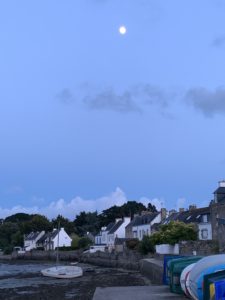 We were lucky enough to visit friends and stay in their lovely new home in Brittany, their hospitality was amazing. Brittany is in Western France, it is bordered by the English Channel to the North and Normandy to the Northeast. It was especially poignant for us to be in this region on D-day, the anniversary of the day on which the allied forces landed in France to push back the Germans during World War II.
We were lucky enough to visit friends and stay in their lovely new home in Brittany, their hospitality was amazing. Brittany is in Western France, it is bordered by the English Channel to the North and Normandy to the Northeast. It was especially poignant for us to be in this region on D-day, the anniversary of the day on which the allied forces landed in France to push back the Germans during World War II.
Our friends house is in a small village called Locmariaquer, which is situated on the shores of the Golfe of Morbihan. One of the first, and most noticeable, things about this area is the dramatic change of tides. Most areas are used to a tidal change of 3 to 4 feet (one meter or so). In the area around Locmariaquer the tidal changes can be up to 18 feet (6 meters). As a result, at high tide the water is lapping at the sea walls and the boats bob happily on their mooring balls. But at low tide there are many kilometers of exposed sea floor and the boats end up resting in the mud, waiting to be floated again as the tide flows in.
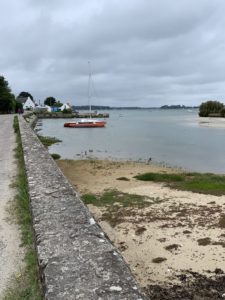
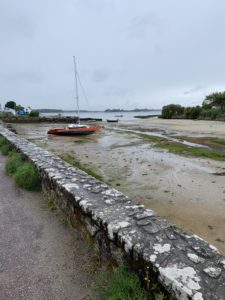 In addition to the boats in the mud, at low tide you can also see row after row of oyster beds, (more about the amazing oysters later). This scene is surreal no matter how many times you see it.
In addition to the boats in the mud, at low tide you can also see row after row of oyster beds, (more about the amazing oysters later). This scene is surreal no matter how many times you see it.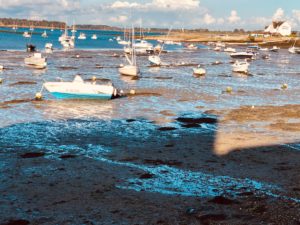
The small village had two bread shops, or boulangeries as they are called in France. Each morning, we enjoyed a leisurely stroll along the “customs walk” (a small path previously used by customs inspectors to review the contents of incoming boats) into the village. In the bread shop we would purchase fresh baguettes, croissants and, George’s favorite, pan du chocolate. The village also has a small convenience store, several gift shops, restaurants, creperies, a library and a small neighborhood bar. We visited the bar which included several different types of musical instruments: guitars, a piano, hand drums, a fiddle and an accordion. Guest were invited to pick up any of 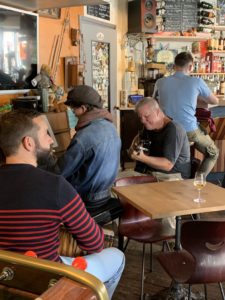
 them and start playing or join into whatever music was happening. George had fun playing guitar with a local piano player, the only language they had in common was music, but they had lot of fun with it.
them and start playing or join into whatever music was happening. George had fun playing guitar with a local piano player, the only language they had in common was music, but they had lot of fun with it.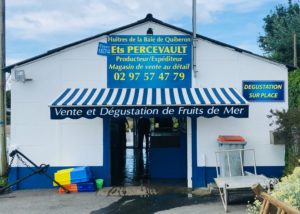
Just around the corner from the house was a small shellfish store. In this store you could purchase oysters or many different types, muscles (moules), lobster, crabs and other shellfish. All were extremely fresh, clean and very much alive. Oysters were €4.50 per kilo with about a dozen per kilo. That works out to about forty cents (U.S.) per fresh delicious oyster. You can be sure we ate a LOT of them!
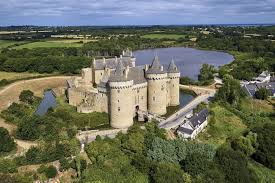 Brittany, or Little Britain (as opposed to great Britain) was once an independent nation with its own Duke. We visited the Domaine de Suscinio that was previously home to the Duke of Brittany from the Middle Ages to the 1800’s. In the 1960’s it was declared a historical site and has been painstakingly restored to an amazing showpiece with lots of interesting displays and educational areas. This castle is well worth a visit if you get to the area.
Brittany, or Little Britain (as opposed to great Britain) was once an independent nation with its own Duke. We visited the Domaine de Suscinio that was previously home to the Duke of Brittany from the Middle Ages to the 1800’s. In the 1960’s it was declared a historical site and has been painstakingly restored to an amazing showpiece with lots of interesting displays and educational areas. This castle is well worth a visit if you get to the area.
We thoroughly enjoyed our relaxing visit to this charming coastal town, so much so that we were sad to leave. But we took heart in knowing that we had a great adventures ahead, so we packed up and headed off to Israel to attend the wedding of one of Bonnie’s students from the Hansen Summer Institute.

